An Analytic Approach to Understanding Process Dynamics in Geodesign Studies
Abstract
:1. Introduction
- (1)
- How does the analysis of log-data help us understand past and current (real-time) geodesign processes?
- (2)
- To what extent can the analysis of log-data guide future geodesign processes?
2. Geodesign
2.1. The Methodological Approach
2.2. The Geodesignhub Platform
2.3. Geodesign Process Analytics
3. GDPA for Studying Process Dynamics
3.1. Enhanced Analytical Structured Framework
3.2. Decision Situation Assessment for a Geodesign Study
- Do different participation strategies/group compositions (aspect 5) influence the number of times a diagram has been selected in the synthesis (aspect 16)?
- Does the background information (aspect 7) influence the appropriation of the “sketching and visualization tool” (aspects 11 and 14)?
- Does the appropriation of the “sketching and visualization tool” (aspects 11 and 14) change between the teams across the steps (aspect 16)?
- Do any group processes (aspect 16—e.g., public 3-min presentation) affect the emergence of new participants’ views (aspects 7 and 19)?
3.3. Hypotheses
- In regard to the first question, we hypothesized that the diagrams created by the expert groups in step 1 would have a greater chance of getting selected in the subsequent designs than those created by the non-expert stakeholders (step 3, 4, and 6). This hypothesis was based on the following observations: (i) the groups of experts created close to 100 diagrams at the very beginning of the process (system teams created at least 10 diagrams in their own system column), which constituted the first set of diagrams available to be selected in the syntheses; (ii) the experts enjoyed greater confidence than the non-expert stakeholders due to their technical knowledge and familiarity with geographical data representations and interfaces.
- The second question aims at gaining insight into the influence of participants’ background information (e.g., age, education level, previous experience with GDH/PSS, academic/working area of concentration, main activity within the area of concentration), on the use of the “sketching and visualization tool” in GDH. Age was expected to be negatively correlated with the propensity to use digital supporting tools, whereas participants who achieved higher education and have already experienced the use of planning and decision support systems would demonstrate greater ease of using the “sketching and visualization tool”. We also expected to find differences in the use of the tool associated with training and main professional activity (e.g., practice, research, student). Architects and planners are expected to have robust visual-spatial thinking skills and greater familiarity with tools for digital sketching and design. In this analysis, the appropriation of the tool was in fact associated with the perceived usefulness and measured by the use frequency, following the rational: if the tool is useful, they use it to create diagrams.
- In question three, we intended to analyze the actual appropriation of the “sketching and visualization tool” within the activities and thus determine whether there were any significant differences between the number of diagrams created across the steps by the stakeholder teams. We argue that, despite facilitators’ instructions, the diagrams creation trend can differ significantly between groups mainly due to the composition of group members and the role represented/played. In fact, the length of time allowed for each activity is defined by facilitator, which can thereby affect the appropriation of the tool. The creation of the first syntheses (step 3) is usually a quick task, in which each team is asked to select diagrams mainly from those created by the expert group in step 1. Whereas in the second and third round of syntheses (steps 4 and 6) they are encouraged to add additional diagrams to better accommodate their interests.
- The last question focuses on the priority weights assigned to the systems by each of the stakeholder teams at the beginning of the process (decision model, step 2) and reflects the values and worldviews of the participants. We hypothesized that the groups changed their views along the process and, specifically, that the mean of priority values associated with the diagrams selected before the three min presentation would be significantly higher than the mean of the priority values associated with the diagrams selected after the three min presentation. This could mean that the groups selected a greater number of diagrams from the systems, which they identified as medium or low priority prior to the diagram synthesis steps in the geodesign process. We posit that the three min presentation of the syntheses, although based on a group-specific set of priorities, may be complementary but important part of the learning process within each team and for all participants. We intended, therefore, to compare the groups’ designs to discover trends (if any) in diagram selection and relationships among systems with different priority weights. In carrying out this comparison, the groups’ values and views were measured for each design as the mean of the priority values (from 1 to 10) associated with the territorial systems, to which the selected diagrams relate.
4. Analysis
4.1. Cagliari Geodesign Workshop
4.2. Data Collection
4.3. Hypotheses Testing
4.3.1. Hypothesis 1
4.3.2. Hypothesis 2
4.3.3. Hypothesis 3
4.3.4. Hypothesis 4
5. Results
5.1. Group Composition Influence
5.2. Background Information Influence
5.3. “Sketching and Visualization Tool” Appropriation
5.4. Group Processes Influence
6. Discussion and Conclusions
Author Contributions
Funding
Conflicts of Interest
References
- Moroni, S. Towards a Reconstruction of the Public Interest Criterion. Plan. Theory 2004, 3, 151–171. [Google Scholar] [CrossRef]
- Rittel, H.W.J.; Webber, M.M. Dilemmas in a General Theory of Planning. Policy Sci. 1973, 4, 155–169. [Google Scholar] [CrossRef]
- Khakee, A. Evaluation and planning: Inseparable concepts. Town Plan. Rev. 1998, 69, 359–374. [Google Scholar] [CrossRef]
- Davidoff, P. Advocacy and pluralism in planning. J. Am. Inst. Plan. 1965, 31, 331–338. [Google Scholar] [CrossRef]
- Healey, P. Collaborative planning in a stakeholder society. Town Plan. Rev. 1998, 69. [Google Scholar] [CrossRef]
- Innes, J.E.; Booher, D.E. Planning with Complexity: An Introduction to Collaborative Rationality for Public Policy; Routledge: London, UK, 2010; ISBN 1-135-19427-0. [Google Scholar]
- Faludi, A. Planning Theory; Pergamon Press: Oxford, UK, 1973; ISBN 978-0-08-017741-0. [Google Scholar]
- Rittel, H.W.J. On the planning crisis: Systems analysis of the ‘first and second generations’. Bedriftsokonomen 1972, 8, 390–396. [Google Scholar]
- Steinitz, C. A Framework for Geodesign: Changing Geography by Design; Esri Press: Redlands, CA, USA, 2012. [Google Scholar]
- Jankowski, P.; Nyerges, T. Geographic Information Sistems for Group Decision Making; CRC Press: London, UK, 2001; ISBN 978-0-203-48490-6. [Google Scholar]
- Pettit, C.; Hawken, S.; Zarpelon, S.; Ticzon, C.; Afrooz, A.; Steinitz, C.; Ballal, H.; Canfield, T.; Lieske, S. Breaking Down the Silos Through Geodesign—Envisioning Sydney’s Urban future. Environ. Plan. B Urban Anal. City Sci. 2019, in press. [Google Scholar]
- Friedmann, J. Retracking America: A Theory of Transactive Planning; Anchor Press: Garden City, NY, USA, 1973. [Google Scholar]
- Healey, P. Planning through Debate: The Communicative Turn in Planning Theory. In The Argumentative Turn in Policy Analysis and Planning; Fischer, F., Forester, J., Eds.; Duke University Press: Durham, NC, USA, 1993; ISBN 978-0-8223-1354-0. [Google Scholar]
- Geertman, S. PSS: Beyond the implementation gap. Transp. Res. Part A Policy Pract. 2017, 104, 70–76. [Google Scholar] [CrossRef]
- Pettit, C.; Bakelmun, A.; Lieske, S.N.; Glackin, S.; Thomson, G.; Shearer, H.; Dia, H.; Newman, P. Planning support systems for smart cities. City Cult. Soc. 2018, 12, 13–24. [Google Scholar] [CrossRef]
- Campagna, M. Metaplanning: About designing the Geodesign process. Landsc. Urban Plan. 2016, 156, 118–128. [Google Scholar] [CrossRef]
- Ballal, H. Collaborative Planning with Digital Design Synthesis. Ph.D. Thesis, UCL (University College London), London, UK, 2015. [Google Scholar]
- Conte, R.; Gilbert, N.; Bonelli, G.; Cioffi-Revilla, C.; Deffuant, G.; Kertesz, J.; Loreto, V.; Moat, S.; Nadal, J.-P.; Sanchez, A.; et al. Manifesto of computational social science. Eur. Phys. J. Spec. Top. 2012, 214, 325–346. [Google Scholar] [CrossRef] [Green Version]
- Van Der Aalst, W. Process Mining: Discovery, Conformance and Enhancement of Business Processes; Springer: Berlin, Germany, 2011; Volume 2. [Google Scholar]
- Cooley, R.; Mobasher, B.; Srivastava, J. Web mining: Information and pattern discovery on the World Wide Web. In Proceedings of the Ninth IEEE International Conference on Tools with Artificial Intelligence, Newport Beach, CA, USA, 3–8 November 1997; pp. 558–567. [Google Scholar]
- Nasraoui, O.; Soliman, M.; Saka, E.; Badia, A.; Germain, R. A Web usage mining framework for mining evolving user profiles in dynamic Web sites. IEEE Trans. Knowl. Data Eng. 2008, 20, 202–215. [Google Scholar] [CrossRef]
- Iqbal, F.; Fung, B.C.M.; Debbabi, M.; Batool, R.; Marrington, A. Wordnet-Based Criminal Networks Mining for Cybercrime Investigation. IEEE Access 2019, 7, 22740–22755. [Google Scholar] [CrossRef]
- Zhang, L.; Ashuri, B. BIM log mining: Discovering social networks. Autom. Constr. 2018, 91, 31–43. [Google Scholar] [CrossRef]
- Becattini, N.; Cascini, G.; O’Hare, J.A.; Morosi, F.; Boujut, J.-F. Extracting and Analysing Design Process Data from Log Files of ICT Supported Co-Creative Sessions. In Proceedings of the Design Society: International Conference on Engineering Design, Delft, The Netherlands, 5–8 August 2019; Volume 1, pp. 129–138. [Google Scholar] [CrossRef]
- Zhang, L.; Wen, M.; Ashuri, B. BIM Log Mining: Measuring Design Productivity. J. Comput. Civ. Eng. 2018, 32, 04017071. [Google Scholar] [CrossRef]
- Carrera, B.; Lee, J.; Jung, J.-Y. Discovering Information Diffusion Processes Based on Hidden Markov Models for Social Network Services. In Proceedings of the Asia Pacific Business Process Management, Busan, Korea, 24–26 June 2015; pp. 170–182. [Google Scholar]
- Campagna, M. Social Media Geographic Information: Why social is special when it goes spatial. In European Handbook Crowdsourced Geographic Information; Ubiquity Press: London, UK, 2016; pp. 45–54. [Google Scholar]
- Ghodousi, M.; Alesheikh, A.A.; Saeidian, B. Analyzing public participant data to evaluate citizen satisfaction and to prioritize their needs via K-means, FCM and ICA. Cities 2016, 55, 70–81. [Google Scholar] [CrossRef]
- Ashtari, D.; de Lange, M. Playful civic skills: A transdisciplinary approach to analyse participatory civic games. Cities 2019, 89, 70–79. [Google Scholar] [CrossRef]
- Wilson, M.W. On the criticality of mapping practices: Geodesign as critical GIS? Landsc. Urban Plan. 2015, 142, 226–234. [Google Scholar] [CrossRef]
- Orland, B.; Steinitz, C. Improving our Global Infrastructure: The International Geodesign Collaboration. In Proceedings of the Journal of Digital Landscape Architecture, Dessau, Germany, 22–25 May 2019; Volume 4, pp. 213–219. [Google Scholar]
- Miller, W.R. Introducing Geodesign: The Concept; Esri Press: Redlands, CA, USA, 2012. [Google Scholar]
- Geertman, S.; Stillwell, J. Planning support systems: An inventory of current practice. Comput. Environ. Urban Syst. 2004, 28, 291–310. [Google Scholar] [CrossRef]
- Vonk, G.; Geertman, S.; Schot, P. Bottlenecks blocking widespread usage of planning support systems. Environ. Plan. A 2005, 37, 909–924. [Google Scholar] [CrossRef]
- Campagna, M.; Carl, S.; Di Cesare, E.A.; Cocco, C.; Hrishikesh, B.; Tess, C. Collaboration in planning: The Geodesign approach. Rozwój Regionalny i Polityka Regionalna 2016, 35, 55–72. [Google Scholar]
- Geodesignhub. Available online: https://www.geodesignhub.com (accessed on 11 September 2019).
- Araújo, R.P.; Moura, A.C.M.; Nogueira, T. Creating Collaborative Environments for the Development of Slum Upgrading and Illegal Settlement Regularization Plans in Brazil: The Maria Tereza Neighborhood Case in Belo Horizonte. Int. J. E-Plan. Res. 2018, 7, 25–43. [Google Scholar]
- Nyerges, T.; Ballal, H.; Steinitz, C.; Canfield, T.; Roderick, M.; Ritzman, J.; Thanatemaneerat, W. Geodesign dynamics for sustainable urban watershed development. Sustain. Cities Soc. 2016, 25, 13–24. [Google Scholar] [CrossRef] [Green Version]
- Rivero, R.; Smith, A.; Ballal, H.; Steinitz, C. Promoting collaborative Geodesign in a multidisciplinary and multiscale environment: Coastal Georgia 2050, USA. Digit. Landsc. Archit. 2015, 1, 42–58. [Google Scholar]
- Freitas, C.R.; Moura, A.C.M. ETL Tools to Analyze Diagrams’ Performance: Favoring Negotiations in Geodesign Workshops. Disegnarecon 2018, 11, 15.1–15.23. [Google Scholar]
- Cocco, C.; Campagna, M. Toward a Geodesign Process Analytics. DISEGNARECON 2018, 11, 3.1–3.8. [Google Scholar]
- Nyerges, T.L.; Jankowski, P. Regional and Urban GIS: A Decision Support Approach; Guilford Press: New York, NY, USA, 2009; ISBN 1-60623-906-6. [Google Scholar]
- Nyerges, T.L.; Jankowski, P. Enhanced adaptive structuration theory: A theory of gis-supported collaborative decision making. Geogr. Syst. 1997, 4, 225–259. [Google Scholar]
- Albert, C.; Von Haaren, C.; Vargas-Moreno, J.C.; Steinitz, C. Teaching Scenario-Based Planning for Sustainable Landscape Development: An Evaluation of Learning Effects in the Cagliari Studio Workshop. Sustainability 2015, 7, 6872–6892. [Google Scholar] [CrossRef] [Green Version]
- Wilcoxon, F. Individual comparisons by ranking methods. Biom. Bull. 1945, 1, 80–83. [Google Scholar] [CrossRef]
- Kendall, M.G. Rank Correlation Methods, 2nd ed.; Hafner Publishing Co.: Oxford, UK, 1955. [Google Scholar]
- Kruskal, W.H.; Wallis, W.A. Use of ranks in one-criterion variance analysis. J. Am. Stat. Assoc. 1952, 47, 583–621. [Google Scholar] [CrossRef]

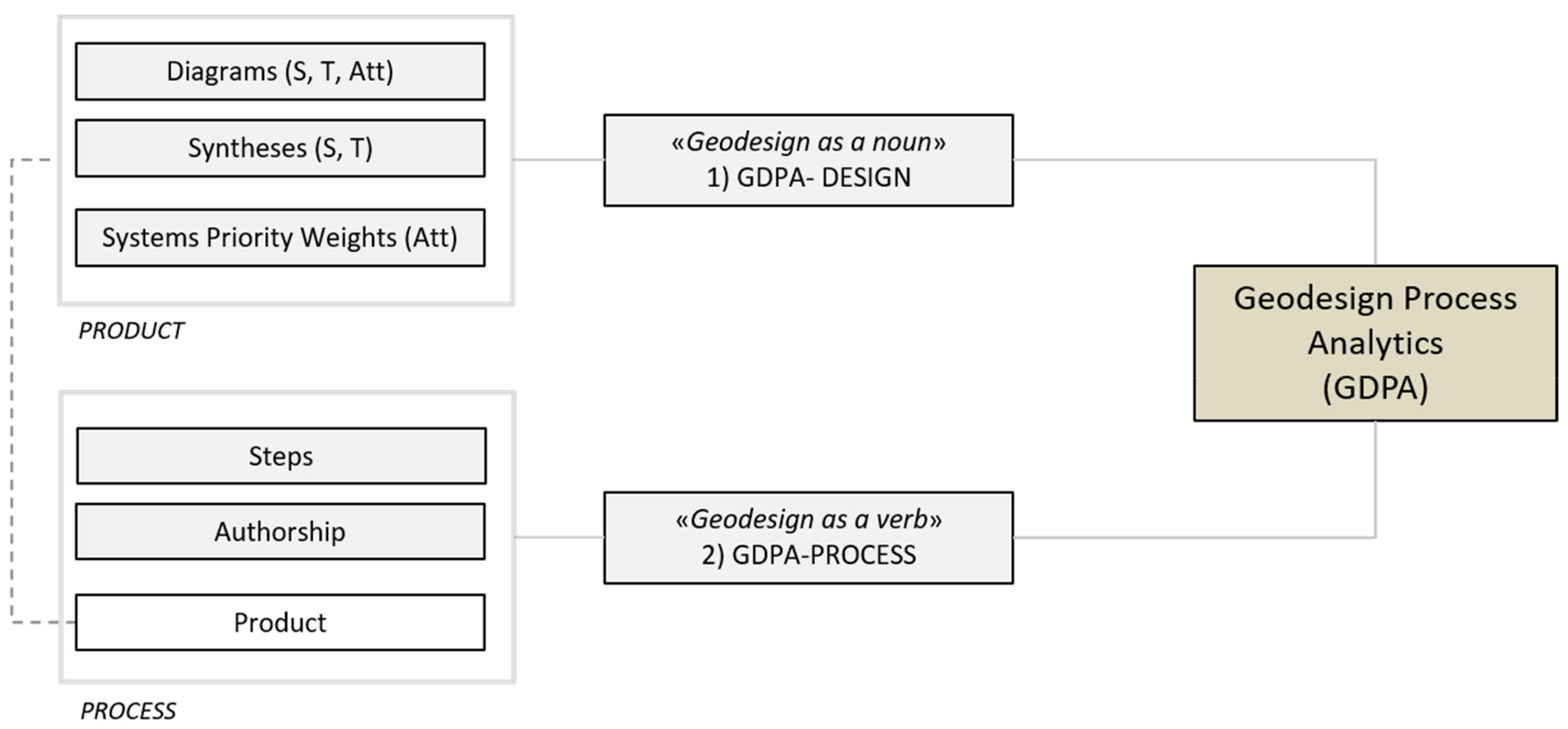

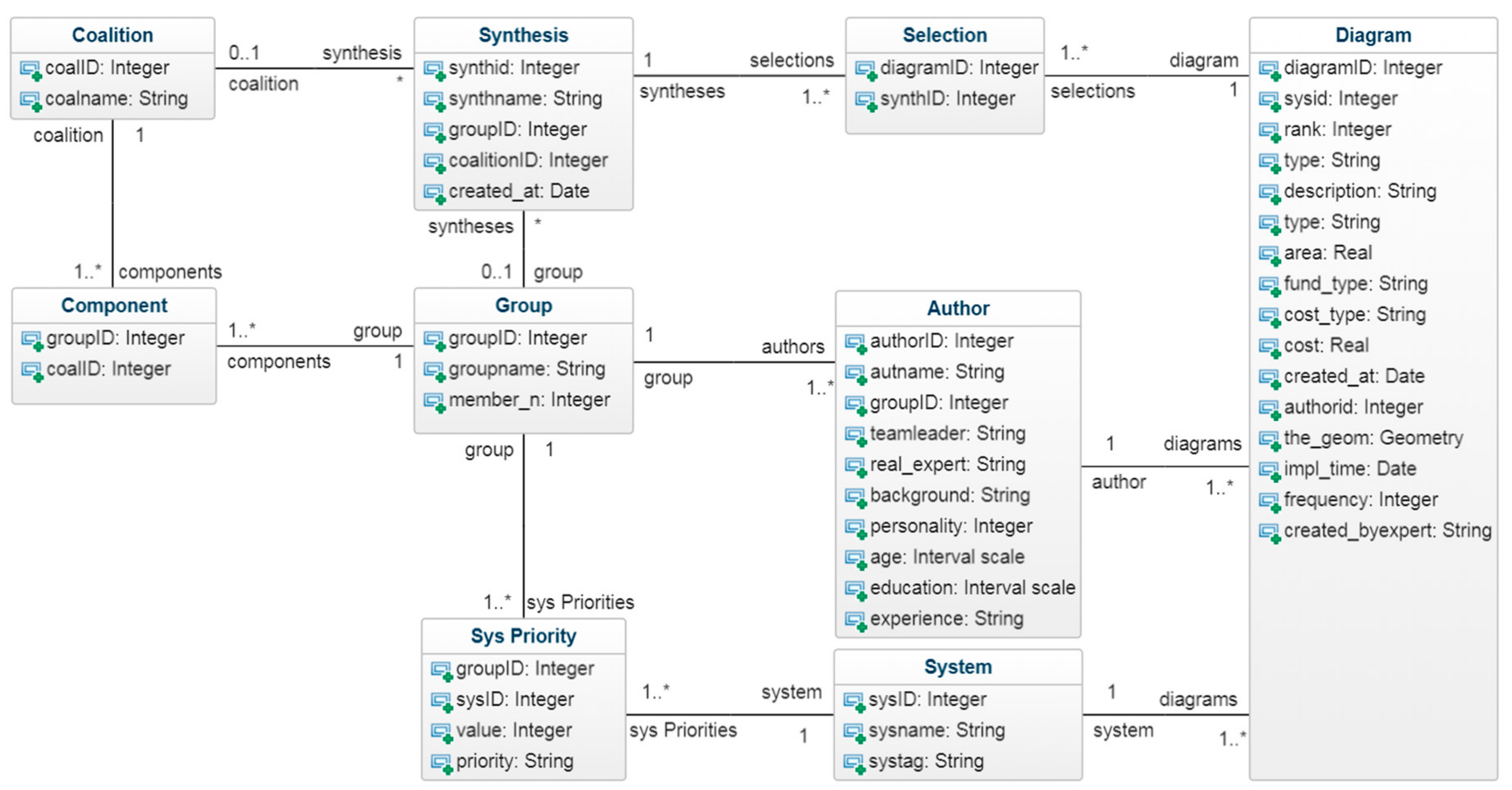


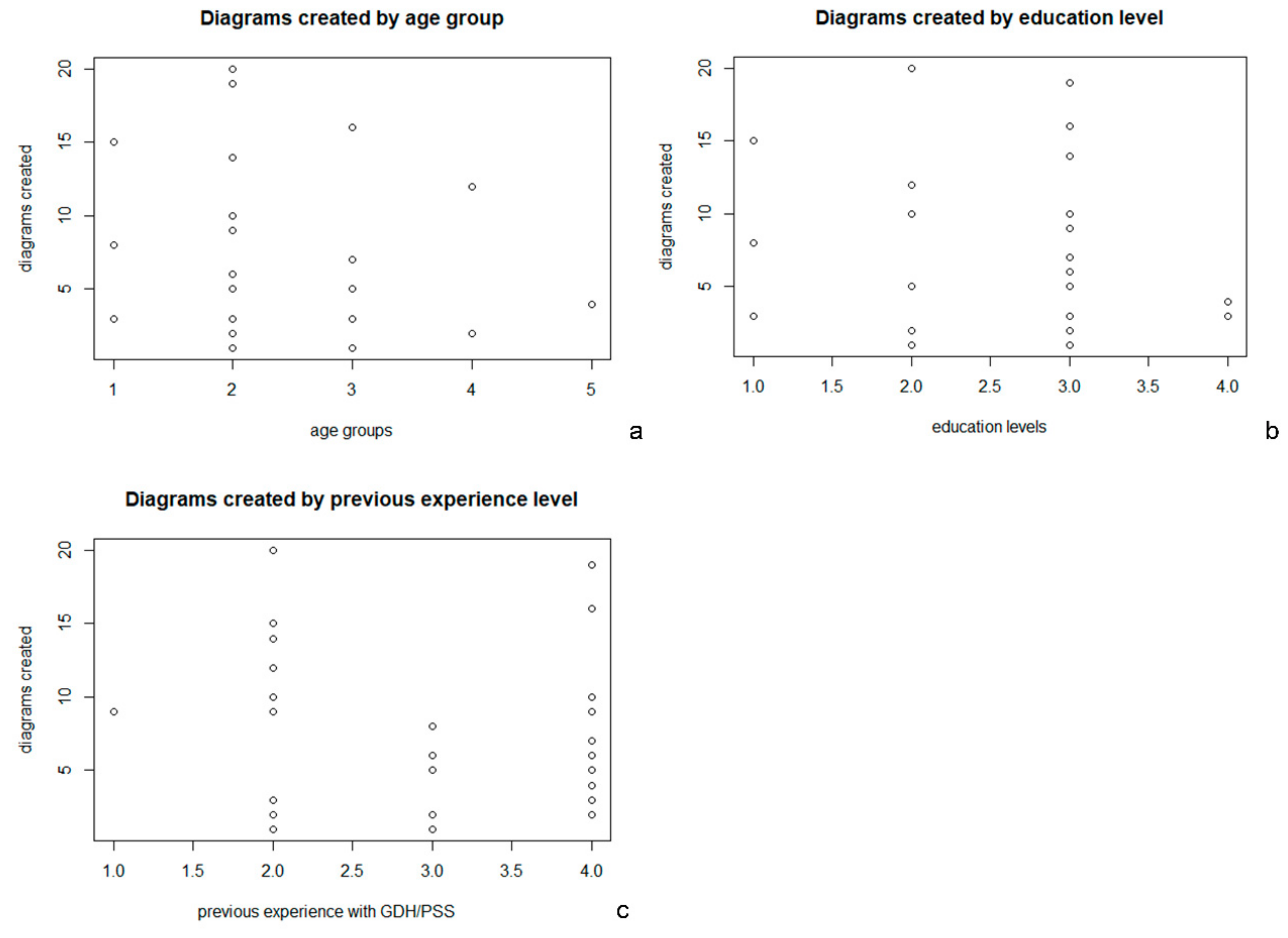
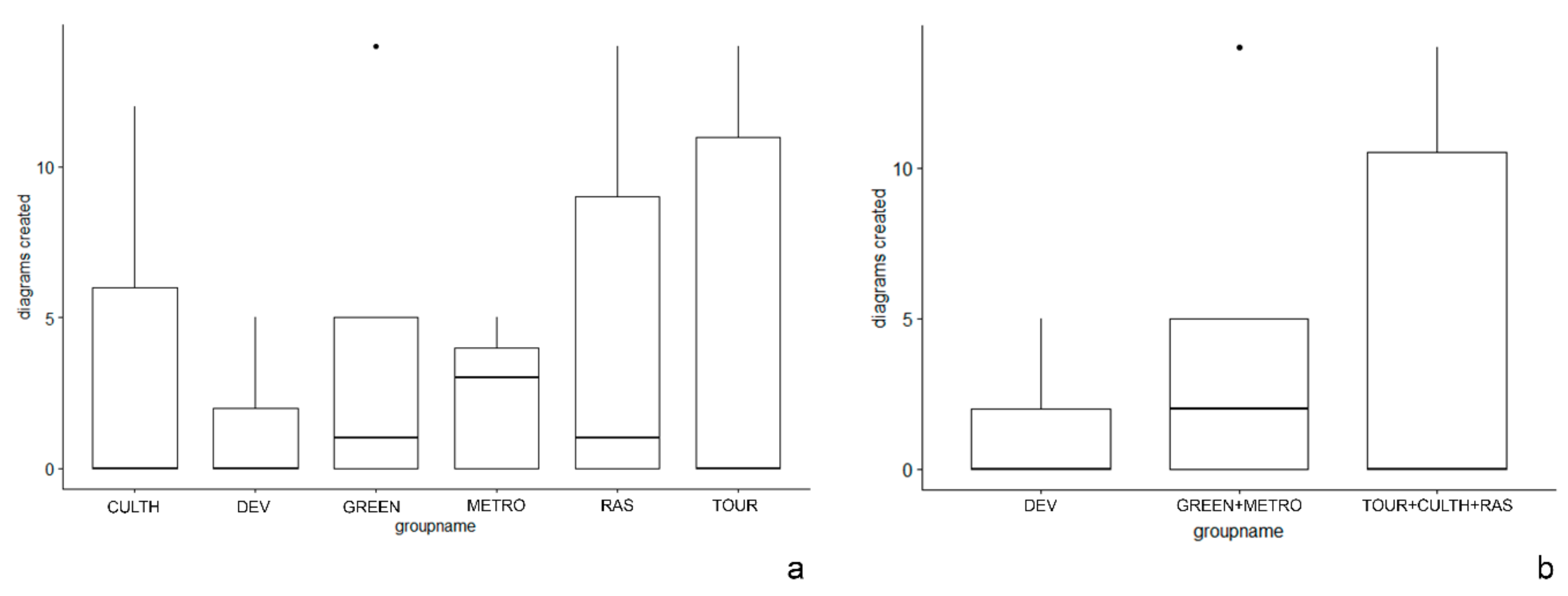
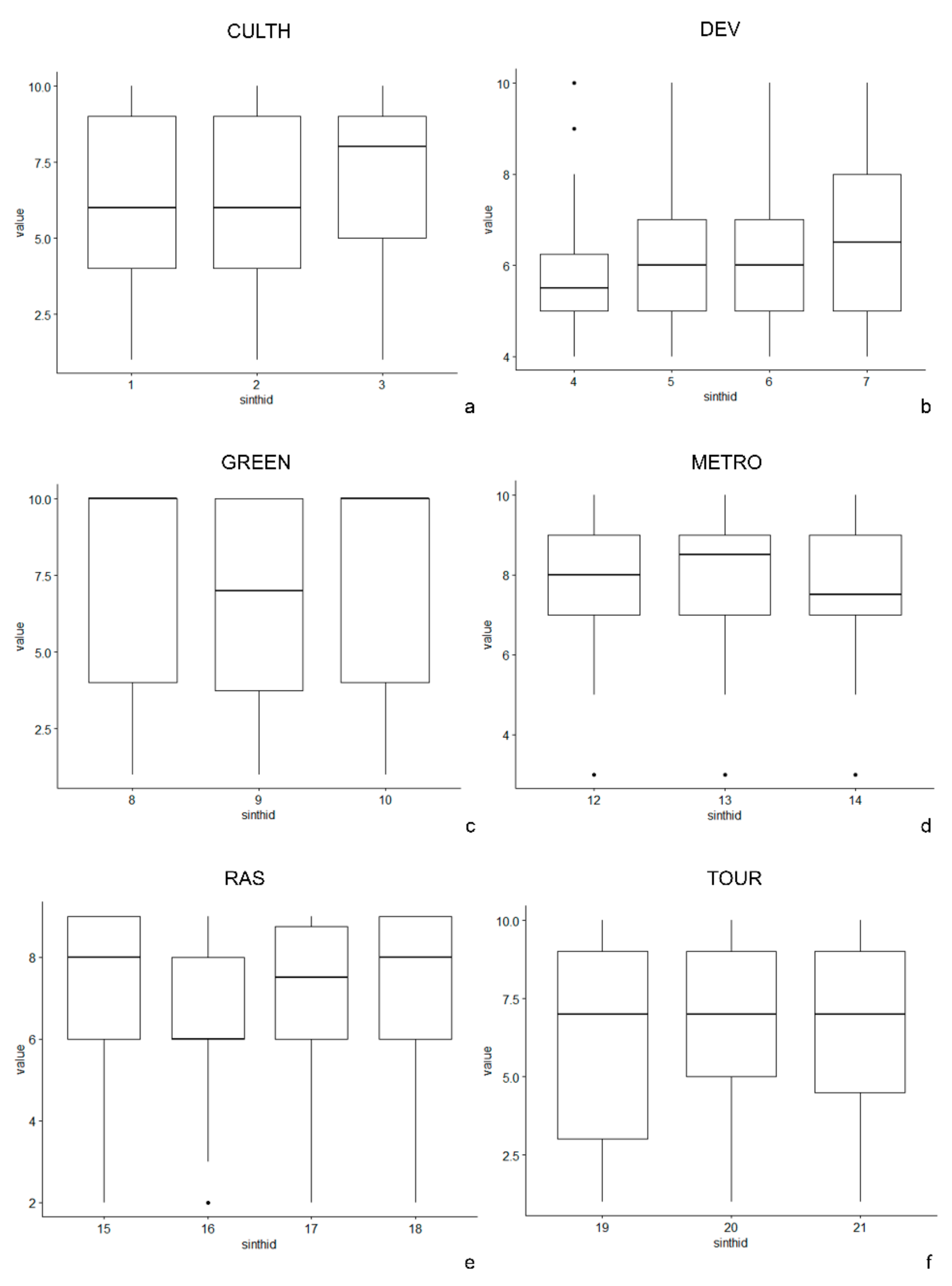

| Step/Group of Steps | ||||||
|---|---|---|---|---|---|---|
| 1 | 2 | 3, 4 | 5 | 6 | 7, 8 | |
| Create Diagrams | Define System Priority Weights | Add Diagrams and Create Design v1, v2 | Make Three Min Presentation | Add Diagrams and Create Design v3 | Create Negotiated Design v1, v2 | |
| Aspect 5 Rules and norm of participation | participants are grouped in system expert teams | participants are grouped in stakeholder teams | teams are grouped into coalitions | |||
| Aspect 7 Participants’ views/knowledge | background information (age, education level, academic/working area of concentration, previous experience with Geodesignhub (GDH)planning support system (PSS) | |||||
| systems’ priority weights stand for stakeholders’ values and their worldviews | selection of diagrams mirror stakeholders’ values and their worldviews | selection of diagrams mirror stakeholders’ values and their worldviews | ||||
| Aspect 11 Geographic information aids | “sketching and visualization tool” | “set priority weights tool” | “sketching and visualization tool”; “design creation tool” | “comparison tool” | “sketching and visualization tool”; “design creation tool” | “sketching and visualization tool”; “comparison tools”; “negotiation tools” |
| Aspect 16 Task management | system teams create diagrams | stakeholder teams assign priority weights (from 1 to 10) | stakeholder teams create additional diagrams and save a collection of diagrams in a design alternative | stakeholder teams shortly present their designs in a large screen | stakeholder teams create additional diagrams and save a selection of diagrams in a design alternative | group coalitions compare their design and strive to reach a consensus through negotiation |
| Attribute “Created_Byexpert” | Count | Mean (Frequency of Selection) | SD |
|---|---|---|---|
| yes | 113 | 3.02 | 2.80 |
| no | 101 | 7.62 | 5.07 |
| Attribute “Age_Group” | Count | Mean (Diagrams Created) | SD |
|---|---|---|---|
| ≤25 | 4 | 7.25 | 5.68 |
| 26–35 | 17 | 7.94 | 5.55 |
| 37–45 | 5 | 6.4 | 5.81 |
| 46–60 | 2 | 7 | 7.07 |
| >60 | 1 | 4 | NaN |
| Attribute “Education” | Count | Mean (Diagrams Created) | SD |
|---|---|---|---|
| undergraduate | 4 | 7.25 | 5.68 |
| graduate | 7 | 7.43 | 6.97 |
| postgraduate | 16 | 7.88 | 4.99 |
| PhD | 2 | 3.5 | 0.707 |
| Attribute “Main_Activity” | Count | Mean (Diagrams Created) | SD |
|---|---|---|---|
| practice | 5 | 9.4 | 7.33 |
| research | 18 | 7.33 | 4.96 |
| student | 6 | 5.83 | 5.08 |
| Attribute “Background” | Count | Mean (Diagrams Created) | SD |
|---|---|---|---|
| architecture, engineering | 9 | 8.44 | 6.64 |
| other | 3 | 7.33 | 3.79 |
| planning | 17 | 6.82 | 5.00 |
| Attribute “Previous_Experience” | Count | Mean (Diagrams Created) | SD |
|---|---|---|---|
| none | 1 | 9 | NaN |
| low | 11 | 8.36 | 6.39 |
| medium | 6 | 4.5 | 2.59 |
| high | 11 | 7.82 | 5.38 |
© 2019 by the authors. Licensee MDPI, Basel, Switzerland. This article is an open access article distributed under the terms and conditions of the Creative Commons Attribution (CC BY) license (http://creativecommons.org/licenses/by/4.0/).
Share and Cite
Cocco, C.; Jankowski, P.; Campagna, M. An Analytic Approach to Understanding Process Dynamics in Geodesign Studies. Sustainability 2019, 11, 4999. https://doi.org/10.3390/su11184999
Cocco C, Jankowski P, Campagna M. An Analytic Approach to Understanding Process Dynamics in Geodesign Studies. Sustainability. 2019; 11(18):4999. https://doi.org/10.3390/su11184999
Chicago/Turabian StyleCocco, Chiara, Piotr Jankowski, and Michele Campagna. 2019. "An Analytic Approach to Understanding Process Dynamics in Geodesign Studies" Sustainability 11, no. 18: 4999. https://doi.org/10.3390/su11184999





